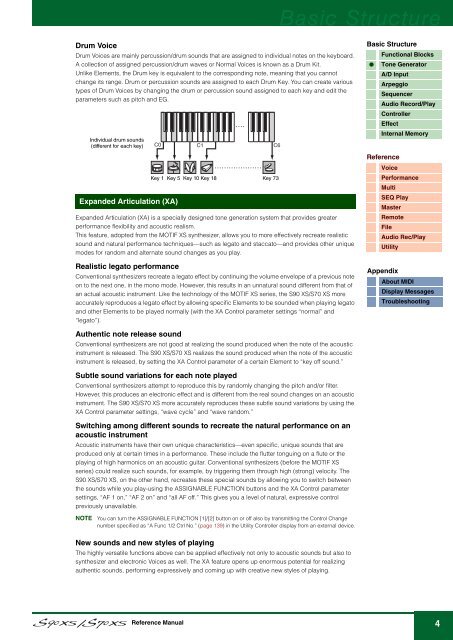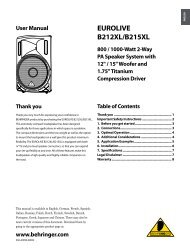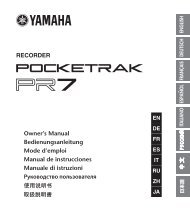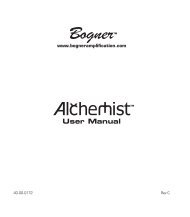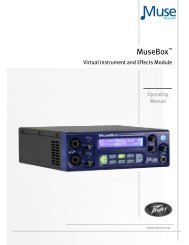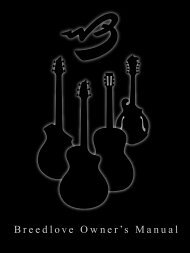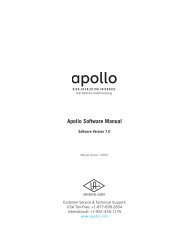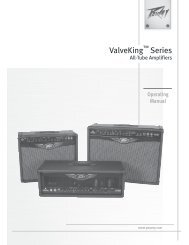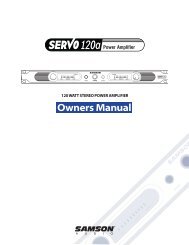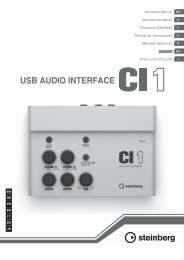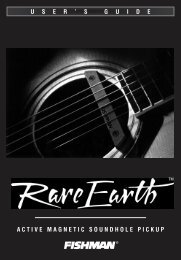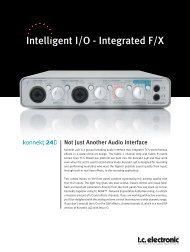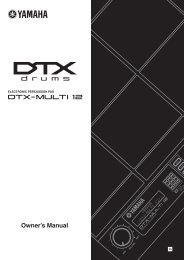S90 XS/S70 XS Reference Manual - zZounds.com
S90 XS/S70 XS Reference Manual - zZounds.com
S90 XS/S70 XS Reference Manual - zZounds.com
Create successful ePaper yourself
Turn your PDF publications into a flip-book with our unique Google optimized e-Paper software.
Basic Structure<br />
Drum Voice<br />
Drum Voices are mainly percussion/drum sounds that are assigned to individual notes on the keyboard.<br />
A collection of assigned percussion/drum waves or Normal Voices is known as a Drum Kit.<br />
Unlike Elements, the Drum key is equivalent to the corresponding note, meaning that you cannot<br />
change its range. Drum or percussion sounds are assigned to each Drum Key. You can create various<br />
types of Drum Voices by changing the drum or percussion sound assigned to each key and edit the<br />
parameters such as pitch and EG.<br />
Individual drum sounds<br />
(different for each key)<br />
Expanded Articulation (XA)<br />
C0 C1 C6<br />
Key 1 Key 5 Key 10 Key 18 Key 73<br />
Expanded Articulation (XA) is a specially designed tone generation system that provides greater<br />
performance flexibility and acoustic realism.<br />
This feature, adopted from the MOTIF <strong>XS</strong> synthesizer, allows you to more effectively recreate realistic<br />
sound and natural performance techniques—such as legato and staccato—and provides other unique<br />
modes for random and alternate sound changes as you play.<br />
Basic Structure<br />
Functional Blocks<br />
Tone Generator<br />
A/D Input<br />
Arpeggio<br />
Sequencer<br />
Audio Record/Play<br />
Controller<br />
Effect<br />
Internal Memory<br />
<strong>Reference</strong><br />
Voice<br />
Performance<br />
Multi<br />
SEQ Play<br />
Master<br />
Remote<br />
File<br />
Audio Rec/Play<br />
Utility<br />
Realistic legato performance<br />
Conventional synthesizers recreate a legato effect by continuing the volume envelope of a previous note<br />
on to the next one, in the mono mode. However, this results in an unnatural sound different from that of<br />
an actual acoustic instrument. Like the technology of the MOTIF <strong>XS</strong> series, the <strong>S90</strong> <strong>XS</strong>/<strong>S70</strong> <strong>XS</strong> more<br />
accurately reproduces a legato effect by allowing specific Elements to be sounded when playing legato<br />
and other Elements to be played normally (with the XA Control parameter settings “normal” and<br />
“legato”).<br />
Authentic note release sound<br />
Conventional synthesizers are not good at realizing the sound produced when the note of the acoustic<br />
instrument is released. The <strong>S90</strong> <strong>XS</strong>/<strong>S70</strong> <strong>XS</strong> realizes the sound produced when the note of the acoustic<br />
instrument is released, by setting the XA Control parameter of a certain Element to “key off sound.”<br />
Subtle sound variations for each note played<br />
Conventional synthesizers attempt to reproduce this by randomly changing the pitch and/or filter.<br />
However, this produces an electronic effect and is different from the real sound changes on an acoustic<br />
instrument. The <strong>S90</strong> <strong>XS</strong>/<strong>S70</strong> <strong>XS</strong> more accurately reproduces these subtle sound variations by using the<br />
XA Control parameter settings, “wave cycle” and “wave random.”<br />
Switching among different sounds to recreate the natural performance on an<br />
acoustic instrument<br />
Acoustic instruments have their own unique characteristics—even specific, unique sounds that are<br />
produced only at certain times in a performance. These include the flutter tonguing on a flute or the<br />
playing of high harmonics on an acoustic guitar. Conventional synthesizers (before the MOTIF <strong>XS</strong><br />
series) could realize such sounds, for example, by triggering them through high (strong) velocity. The<br />
<strong>S90</strong> <strong>XS</strong>/<strong>S70</strong> <strong>XS</strong>, on the other hand, recreates these special sounds by allowing you to switch between<br />
the sounds while you play-using the ASSIGNABLE FUNCTION buttons and the XA Control parameter<br />
settings, “AF 1 on,” “AF 2 on” and “all AF off.” This gives you a level of natural, expressive control<br />
previously unavailable.<br />
Appendix<br />
About MIDI<br />
Display Messages<br />
Troubleshooting<br />
NOTE<br />
You can turn the ASSIGNABLE FUNCTION [1]/[2] button on or off also by transmitting the Control Change<br />
number specified as “A Func 1/2 Ctrl No.” (page 139) in the Utility Controller display from an external device.<br />
New sounds and new styles of playing<br />
The highly versatile functions above can be applied effectively not only to acoustic sounds but also to<br />
synthesizer and electronic Voices as well. The XA feature opens up enormous potential for realizing<br />
authentic sounds, performing expressively and <strong>com</strong>ing up with creative new styles of playing.<br />
<strong>Reference</strong> <strong>Manual</strong><br />
4


